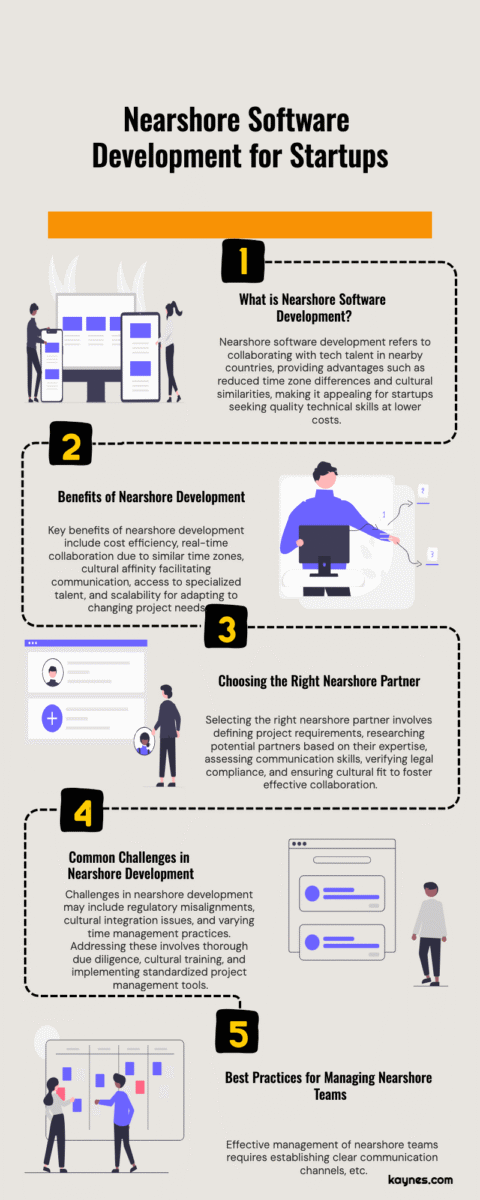
Nearshore Software Development for Startups: The Definitive Guide
This guide is a complete resource on nearshore software development for startups, offering actionable tips to maximize your development projects.
Thank you for reading this post, don't forget to subscribe!So if you’re looking to maximize the potential of nearshore software development for your startup, you’ll find the actionable insights in this guide invaluable.
Let’s get started.
Chapter 1: Nearshore Development

Nearshore Development Fundamentals
In this chapter, I’ll answer the question: “What Is Nearshore Software Development?”
I’ll also explain why nearshore development is a strategic choice for startups.
Let’s dive in.
What Is Nearshore Software Development?
Nearshore software development involves collaborating with tech talent in neighboring or nearby countries for software projects. This strategy bridges the gap between onshore and offshore models, offering geographical and cultural advantages, such as fewer time zone differences and smoother communication.
For startups, this model enables access to a wider talent pool while maintaining better control over the project than offshore options. It’s a strategic choice when you need technical skills at a more affordable cost without sacrificing the convenience of proximity.
Why Choose Nearshore Development?
When you choose nearshore development, you’re combining cost efficiency with operational advantages. Nearshore partners typically share similar time zones, allowing for real-time collaboration. Plus, cultural alignment with your home country makes working together smoother and reduces misunderstandings.
Whether you need a development partner who understands your vision or you want the flexibility to meet face-to-face without flying halfway across the world, nearshoring can provide that middle ground between quality and affordability.
Nearshore vs. Offshore
Although offshore development may seem appealing because of lower costs, it often comes with challenges like communication delays and cultural differences. Nearshore development minimizes these pain points by offering similar time zones, smoother communication, and more cultural compatibility.
Chapter 2: Benefits of Nearshore Software Development

Before we explore the specific advantages of nearshore development, it’s important to understand what makes these benefits so impactful for your startup.
By focusing on the right factors, you can fully leverage nearshore development to accelerate your growth.
With that in mind, here’s a closer look at the key benefits you should prioritize.
Cost Efficiency
One of the main draws of nearshoring is cost savings. Labor costs in nearshore locations are typically much lower than in North America or Western Europe, while the quality of work remains high. This allows startups to stretch their budgets further without compromising on talent.
Time Zone and Communication
Having your development team in a nearby time zone means you can collaborate in real time, which is invaluable for maintaining project momentum and addressing issues quickly. Meetings can happen during regular business hours, allowing seamless communication compared to offshore alternatives where you might need to wait 12+ hours for a response.
Cultural Affinity
Cultural affinity plays a significant role in the success of any business relationship. Nearshoring often provides a better cultural fit due to shared languages, business practices, and work ethics. This helps to foster a stronger working relationship and avoid miscommunication, making day-to-day collaboration smoother.
Access to Specialized Talent
Depending on your project’s needs, it can be difficult to find the right talent locally. Nearshore regions, especially in countries like Mexico, Brazil, or Colombia, have large pools of skilled developers. Whether you need expertise in specific programming languages or emerging technologies, nearshoring gives you access to high-quality, specialized talent.
Scalability
Nearshoring allows you to scale your development team quickly and efficiently. As your startup grows, you can adjust your team size based on your project needs without dealing with the overhead and complexity of hiring full-time employees in-house.
Chapter 3: How to Choose the Right Nearshore Partner

It’s no secret that selecting the right nearshore partner is crucial to your project’s success.
But here’s the thing:
Simply partnering with any development firm won’t guarantee the results you need.
Certain criteria are essential when choosing a nearshore partner.
Here are the key factors you should focus on to find the perfect match for your startup:
Steps for Selecting a Nearshore Partner
- Define Your Project Requirements
Start by clearly defining the scope and objectives of your project. Understand the technologies you need, the skills required, and the deadlines you’re working towards. This will help you assess potential partners based on their strengths and fit. - Research Potential Partners
Look for nearshore firms with a proven track record in your industry or with similar projects. Investigate their case studies and see if they have experience solving the kinds of challenges your startup faces. - Evaluate Experience and Expertise
Assess the experience and expertise of each candidate. Check their portfolios and client testimonials. Make sure they’re proficient in the technologies you need and that they understand the unique demands of a startup environment, such as agility and fast iterations. - Assess Communication Skills
Clear communication is critical when working with a nearshore team. Ensure your partner has strong communication processes and that language barriers won’t hinder collaboration. Make sure they’re responsive and have transparent reporting practices. - Verify Legal and Security Measures
Ensure your nearshore partner complies with relevant legal regulations, including intellectual property rights, data protection standards, and other industry-specific legalities. Confirm they have robust security protocols to protect your data. - Consider Cultural Fit
Choosing a partner that shares similar cultural values can make your collaboration much smoother. Assess their work culture to see if it aligns with your startup’s values. A good cultural fit can lead to better teamwork, smoother interactions, and a successful long-term relationship.
Chapter 4: Best Practices for Managing Nearshore Teams
If you want to ensure your nearshore development project succeeds presently (and beyond), effective team management is key.
The question is:
How can you manage a remote team effectively without running into communication breakdowns or project delays?
Read this chapter to find out.
Effective Management Tips
- Establish Clear Communication Channels
Leverage communication tools like Slack, Zoom, and Trello to keep everyone aligned. Ensure that your team knows how and when to reach each other and that collaboration is seamless. - Set Clear Expectations
Define roles, responsibilities, and deliverables from the outset. A detailed project roadmap and timeline will help keep everyone on track and reduce confusion down the line. - Regular Check-ins and Feedback
Regular check-ins (daily or weekly, depending on your project) are crucial for monitoring progress and addressing any issues before they escalate. Feedback loops ensure everyone stays on the same page and can adjust quickly. - Leverage Agile Methodologies
Agile development is highly effective when managing nearshore teams. Break your project into sprints, with regular reviews to make iterative improvements. This approach keeps your team nimble and responsive to changes. - Cultural Sensitivity and Team Building
Be mindful of cultural differences and work to bridge any gaps. Schedule virtual team-building activities to foster a strong collaborative spirit and ensure that both teams feel like part of the same mission.
Chapter 5: Common Challenges and How to Overcome Them

No guide to nearshore software development for startups would be complete without addressing the potential challenges.
Challenges are often easy to spot: If an issue disrupts communication, quality, or timelines, it’s a challenge you need to address.
Does that mean you should avoid nearshore development altogether?
That’s a decision only you can make. I personally believe the benefits far outweigh the challenges, but it’s up to you.
That said, whether you’re new to nearshoring or experienced, it’s crucial to understand the common challenges and how to overcome them.
So let’s dive into those now:
Regulatory and Compliance Misalignment
Consequences:
- Legal Risks: If your nearshore partner is not fully compliant with relevant industry regulations and standards, your startup could face legal issues, including fines or penalties.
- Project Delays: Non-compliance can lead to delays as you may need to redo work or make significant adjustments to meet regulatory requirements.
Solution:
- Thorough Due Diligence: Before selecting a nearshore partner, conduct a comprehensive audit of their compliance with industry regulations specific to your sector (e.g., GDPR, HIPAA).
- Contractual Clauses: Include detailed compliance requirements in your contract. Ensure your nearshore partner agrees to adhere to these standards and provides regular compliance reports.
- Regular Audits: Implement periodic audits to review compliance status and address any issues promptly. This proactive approach helps prevent legal complications and ensures adherence to standards throughout the development process.
Cultural Integration Issues
Consequences:
- Misaligned Objectives: Cultural differences can lead to misunderstandings about project goals, work ethics, and expectations, causing friction between your in-house team and the nearshore team.
- Reduced Collaboration: Misaligned cultural values may impact teamwork and collaboration, leading to inefficiencies and decreased productivity.
Solution:
- Cultural Training: Provide cultural sensitivity training for both your in-house team and the nearshore team. This training should cover communication styles, work ethics, and cultural norms.
- Regular Interaction: Foster cultural integration by scheduling regular cross-team interactions, such as joint workshops or team-building activities, to build rapport and mutual understanding.
- Define Expectations Clearly: Set clear expectations regarding work processes, communication norms, and project goals to ensure alignment and minimize cultural misunderstandings.
Inadequate Scalability Planning
Consequences:
- Resource Constraints: If scalability is not adequately planned, you might encounter issues like insufficient resources or delayed responses when scaling your team up or down.
- Inflexible Project Timelines: Poor scalability planning can result in inflexible project timelines, making it difficult to adapt to changing business needs or market conditions.
Solution:
- Scalability Assessments: Work with your nearshore partner to assess scalability requirements from the outset. Discuss potential scenarios and ensure that the partner has the capacity to scale resources as needed.
- Flexible Contracts: Design contracts with flexible terms that allow you to adjust the scope and scale of the project as needed. This flexibility should include provisions for scaling up or down based on project demands.
- Establish Agile Processes: Adopt Agile methodologies that support iterative development and allow for quick adjustments to project scope and team size. Regularly review and adjust the project plan to accommodate changing needs.
Unanticipated Infrastructure Constraints
Consequences:
- Performance Issues: If your nearshore partner operates with outdated or inadequate infrastructure, it can lead to performance bottlenecks, such as slower development cycles or inefficient processing speeds.
- Integration Difficulties: Poor infrastructure may complicate the integration of your nearshore-developed components with your existing systems, causing unexpected integration issues.
Solution:
- Infrastructure Assessment: Before engaging with a nearshore partner, conduct a thorough assessment of their infrastructure capabilities. This includes evaluating their hardware, network reliability, and development tools.
- Performance Benchmarks: Establish clear performance benchmarks and requirements that your nearshore partner must meet. This can include minimum system specifications, network speeds, and development environment standards.
- Infrastructure Upgrades: If your partner’s infrastructure is lacking, consider negotiating a plan for them to upgrade their systems or provide additional resources. Alternatively, you might explore hybrid solutions where critical components are developed in-house or with partners who have more robust infrastructure.
Inconsistent Time Management Practices
Consequences:
- Project Scheduling Conflicts: Inconsistent time management practices can result in scheduling conflicts, missed deadlines, and misalignment with your startup’s project timelines.
- Inefficient Resource Allocation: Variability in time management can lead to inefficient resource allocation, with some team members overloaded while others are underutilized, impacting overall productivity.
Solution:
- Unified Time Management Tools: Implement standardized time management and project tracking tools across both teams. Tools like Jira, Asana, or Monday.com can help synchronize schedules and track progress consistently.
- Time Management Training: Provide training or workshops on effective time management practices to both your in-house team and the nearshore team. This can include best practices for prioritization, task scheduling, and deadline adherence.
- Regular Time Audits: Conduct regular audits of time management practices to identify discrepancies and areas for improvement. Use these insights to adjust processes and ensure that time management practices align with your project requirements.
Complex Intellectual Property (IP) Ownership and Management
Consequences:
- Legal Disputes: Unclear or poorly defined IP ownership can lead to legal disputes over who owns the rights to developed code, technologies, or proprietary processes.
- Confidentiality Risks: Insufficient IP management can expose sensitive information or proprietary technologies to unauthorized parties, increasing the risk of intellectual property theft.
Solution:
- Detailed IP Agreements: Develop detailed intellectual property agreements that clearly define the ownership, usage rights, and responsibilities related to the IP created during the project. Ensure these agreements are reviewed by legal experts to cover all potential scenarios.
- IP Audits and Documentation: Maintain thorough documentation of IP-related activities, including development milestones, contributions, and ownership. Conduct regular IP audits to ensure compliance with agreements and to address any potential disputes proactively.
- Confidentiality Measures: Implement strict confidentiality measures, including non-disclosure agreements (NDAs) and secure development environments. Ensure that all team members, both in-house and nearshore, understand and adhere to these measures to protect your intellectual property.
Disparities in Development Methodologies
Consequences:
- Process Misalignment: Differences in development methodologies between your team and the nearshore partner can result in process mismatches, leading to inefficiencies and project delays.
- Inconsistent Deliverables: Discrepancies in how development practices are implemented can affect the consistency and quality of deliverables.
Solution:
- Methodology Alignment: Conduct workshops or training sessions to align development methodologies and ensure both teams follow a unified approach. Regularly review and update practices to stay synchronized.
- Process Documentation: Create detailed documentation of development processes and expectations, and ensure that both teams adhere to these guidelines. This helps maintain consistency and clarity throughout the project lifecycle.

Variability in Resource Availability
Consequences:
- Project Bottlenecks: Unpredictable resource availability, such as sudden team member absences or fluctuations in resource allocation, can lead to project bottlenecks and delays.
- Increased Costs: Variability in resource availability may necessitate urgent hiring or outsourcing of additional resources, potentially increasing project costs.
Solution:
- Resource Planning: Develop a robust resource planning strategy that includes contingency plans for handling sudden changes in resource availability. This may involve having a pool of backup resources or cross-training team members.
- Regular Status Updates: Implement regular status updates and resource reviews to monitor availability and adjust plans proactively. This helps in identifying potential issues early and managing resources more effectively.
Misalignment in Security Protocols
Consequences:
- Data Breaches: Differences in security protocols between your team and the nearshore partner can lead to vulnerabilities and potential data breaches, putting sensitive information at risk.
- Compliance Issues: Inconsistent security practices may result in non-compliance with industry regulations, leading to legal and financial repercussions.
Solution:
- Unified Security Standards: Establish and enforce a set of unified security standards and protocols that both your team and the nearshore partner must follow. This includes data encryption, secure access controls, and regular security audits.
- Security Training: Provide security training for all team members to ensure they are aware of and adhere to best practices. Regularly update training programs to address emerging threats and changes in security requirements.
Communication Barriers Beyond Language
Consequences:
- Misalignment of Objectives: Misunderstandings that go beyond language—such as differing interpretations of project goals, terminology, or expectations—can lead to misaligned objectives and deliverables.
- Decreased Team Morale: Persistent communication issues can create frustration and reduce team morale, affecting overall productivity and collaboration.
Solution:
- Cultural Training and Integration: Invest in cultural training for both your in-house team and the nearshore team. This training should cover not just language but also cultural norms, business etiquette, and communication styles.
- Clear Documentation and Visual Aids: Use comprehensive documentation and visual aids (e.g., diagrams, flowcharts) to clarify complex concepts and expectations. This helps bridge communication gaps and ensures that everyone is on the same page.
- Regular Feedback Loops: Establish regular feedback loops where both teams can discuss and address any communication issues. Use these sessions to clarify misunderstandings and adjust communication strategies as needed.
Time Zone Differences and Regional Holidays
Consequences:
- Coordination Challenges: Even with nearshore partners in similar time zones, coordinating schedules can be challenging due to differences in regional holidays or varying work hours.
- Delayed Response Times: Time zone discrepancies can lead to delays in responses and decision-making, potentially slowing down project progress and causing frustration.
Solution:
- Overlap Scheduling: Create overlapping work hours where both teams can collaborate in real-time. Define core hours when both teams are available for meetings and discussions to minimize delays.
- Advance Planning: Plan for regional holidays and time zone differences by setting deadlines and milestones well in advance. Communicate these plans early to accommodate for any potential disruptions.
- Asynchronous Communication: Implement robust asynchronous communication practices, such as detailed status updates and comprehensive documentation, to ensure that work continues smoothly despite time zone differences.
Quality Control Across Borders
Consequences:
- Inconsistent Standards: Maintaining consistent quality control can be challenging when working with teams across different locations, leading to varying standards and potential defects.
- Increased Rework: Variability in quality may result in increased rework, debugging, and testing, which can delay project timelines and inflate costs.
Solution:
- Standardized Quality Guidelines: Develop and enforce standardized quality control guidelines and best practices that both teams must follow. Document these guidelines clearly and ensure they are accessible to all team members.
- Frequent Code Reviews and Testing: Implement frequent code reviews and testing procedures to catch and address quality issues early. Use automated testing tools and continuous integration systems to maintain high standards.
- Collaborative Quality Assurance: Foster a collaborative approach to quality assurance by involving both teams in the review and testing process. Encourage joint problem-solving and knowledge sharing to improve quality control across borders.
Chapter 6: Examples

No introduction is needed for this chapter.
Here are three examples of startups that achieved remarkable success through nearshore software development for startups:
Tech Startup Success
A small startup in the health tech sector collaborated with a nearshore development team in Colombia to build their MVP. The collaboration was seamless, and they successfully delivered their product on time, helping them secure a significant round of funding.
Scaling Quickly
A fast-growing e-commerce platform expanded its development capabilities by integrating a nearshore team in Brazil. They were able to scale up their operations quickly during peak seasons without the overhead of hiring full-time developers.
Enhancing Expertise
A financial software company partnered with a nearshore team in Argentina to access specialized cybersecurity expertise. This collaboration significantly improved the security features of their product, increasing client trust and satisfaction.
Chapter 7: Tips for Nearshore Development

Here’s a quick list of nearshore development tips that I’ve gathered through years of experience.
Tech Startups: Build a Modular MVP with Nearshore Teams
For tech startups, it’s crucial to develop a Minimum Viable Product (MVP) that is both scalable and flexible. Nearshore teams can be instrumental in building modular MVPs that allow for rapid iterations and integration of new features as your startup evolves. Focus on leveraging nearshore talent to design a modular architecture that supports microservices, making it easier to update or replace parts of your application without overhauling the entire system.
Health Tech Startups: Prioritize Compliance and Data Security
Health tech startups working with nearshore partners must navigate complex regulatory landscapes like HIPAA in the U.S. or GDPR in Europe. Collaborate with your nearshore team to implement robust data encryption, secure APIs, and compliance-focused workflows from the outset. Regularly audit your nearshore partner’s compliance with these regulations to ensure your product meets all legal standards, avoiding costly breaches or fines.
Fintech Startups: Leverage Blockchain and Fintech Expertise
For fintech startups, tapping into nearshore talent with specialized knowledge in blockchain, cryptocurrency, or fintech regulations can give you a competitive edge. Use your nearshore team to develop secure, scalable blockchain solutions or to integrate cutting-edge fintech APIs. Collaborate closely to ensure your financial products meet the stringent security and compliance requirements of the industry.
E-commerce Startups: Optimize for Omnichannel Experiences
E-commerce startups must deliver seamless omnichannel experiences. Nearshore teams can help you develop integrated platforms that unify your online and offline customer interactions. Leverage their expertise in building robust back-end systems that support inventory management, order processing, and customer service across multiple channels. Focus on personalization and AI-driven recommendations to enhance the customer experience.
SaaS Startups: Focus on Multi-Tenancy Architecture
For SaaS startups, scalability is key. Collaborate with your nearshore team to develop a multi-tenancy architecture that allows multiple customers to share the same application instance while keeping their data isolated. This approach can reduce costs and streamline updates, as you maintain a single codebase. Ensure your nearshore team understands the nuances of multi-tenancy, including tenant isolation, data partitioning, and performance optimization.
EdTech Startups: Integrate Adaptive Learning Technologies
EdTech startups can gain a significant advantage by integrating adaptive learning technologies into their platforms. Nearshore teams with expertise in AI and machine learning can help you develop algorithms that tailor educational content to individual learner needs. This can enhance user engagement and improve learning outcomes, making your platform more attractive to educational institutions and end-users.
PropTech (property technology) Startups: Innovate with IoT and Smart Technologies
PropTech startups should consider integrating IoT and smart technologies to create innovative solutions for real estate management. Collaborate with your nearshore team to develop IoT-enabled platforms that can monitor building conditions, optimize energy usage, or enhance security. Ensure your nearshore team is well-versed in IoT protocols and has experience in deploying smart technology solutions in the real estate sector.
Why Choose Kaynes for Nearshore Software Development for Startups?
Tailored Development Solutions
- Curated Expertise: Our team of developers, testers, designers, and infrastructure engineers is meticulously selected to match the unique demands of your startup. This ensures that you receive the highest caliber of talent tailored specifically for your project.
- Dedicated Project Management: A dedicated project manager will oversee every aspect of your project, providing consistent updates and ensuring a seamless execution from inception to completion.
Key Advantages of Partnering with Us
- Access to Elite Talent: Gain entry to the top 1% of tech talent without the hassle of lengthy recruitment processes. Our rigorous vetting ensures you get experts with exceptional skills and industry experience.
- Effective Communication: Our nearshore team works within your time zone, facilitating timely and clear communication. We prioritize open channels and responsive feedback to keep your project on track.
- Speedy Onboarding: Bypass the usual recruitment delays with our rapid team assembly. We swiftly onboard the right experts to align with your project’s schedule and requirements.
- Cultural Compatibility: Our developers are rigorously assessed for both technical and soft skills, ensuring they integrate seamlessly with your startup’s culture and operational style.
Why Nearshore with Us?
- Scalable Solutions: Easily scale your team up or down as your startup evolves, whether you need additional developers, UX designers, or DevOps specialists.
- Flexible Management Options: Decide whether to manage the team yourself or let us handle day-to-day project management, so you can focus on scaling your business.
- Efficient Process: From initial consultation to project delivery, our process is designed to be straightforward, efficient, and tailored to the needs of startups.
Start Your Journey Today
Ready to propel your startup with top-notch nearshore software development? Schedule a call with us to explore how we can help you achieve your goals.
Frequently Asked Questions

Is Nearshore Software Development Cost-Effective for Startups?
Nearshore software development can be highly cost-effective for startups. Here’s why:
Reduced Labor Costs: Nearshore teams often offer competitive pricing compared to local, in-house developers, especially if you’re based in a high-cost region. This can significantly lower your overall development expenses while maintaining high quality.
Access to Specialized Talent: Nearshore partners can provide access to a broad pool of skilled professionals without the lengthy and costly recruitment process. This enables startups to leverage expertise that might otherwise be unavailable or prohibitively expensive.
Scalability and Flexibility: Nearshore development allows startups to quickly scale their teams up or down based on project needs. This flexibility can prevent over-investment in permanent staff and adapt to fluctuating workloads, helping to manage costs effectively.
Reduced Overhead Costs: By outsourcing development, startups can avoid the overhead costs associated with maintaining an in-house team, such as office space, equipment, and employee benefits.
How Does Nearshore Software Development Compare to In-House Development for Early-Stage Companies?
Nearshore software development offers several distinct advantages over in-house development for early-stage companies:
Faster Time-to-Market: Nearshore teams often have the experience and resources to accelerate development timelines. This can be crucial for startups needing to quickly launch products and gain a competitive edge.
Cost Efficiency: Compared to hiring a full-time in-house team, which involves significant recruitment, training, and overhead costs, nearshore development can be more budget-friendly. Startups benefit from the lower rates and avoid long-term financial commitments.
Access to Expertise: Nearshore partners can provide specialized skills and knowledge that may be challenging to find locally or require time to develop in-house. This is particularly beneficial for startups needing advanced technological capabilities or niche expertise.
Focus on Core Business: Outsourcing software development allows startups to concentrate on their core business activities and strategic growth. By delegating the development work to a nearshore team, founders can dedicate more time to product development, marketing, and scaling their business.
Risk Management: Nearshore development can help mitigate risks associated with hiring and managing a full-time, local development team. It provides flexibility and scalability while sharing the project management burden with experienced partners.
Overall, nearshore software development can be a strategic choice for early-stage companies looking to optimize costs, access top talent, and accelerate their growth while focusing on core business objectives.
Discover more about how our services can support and accelerate your startup’s success.
External Links
https://www.ibm.com/topics/risk-management
https://www.techtarget.com/searchsecurity/definition/What-is-risk-management-and-why-is-it-important


